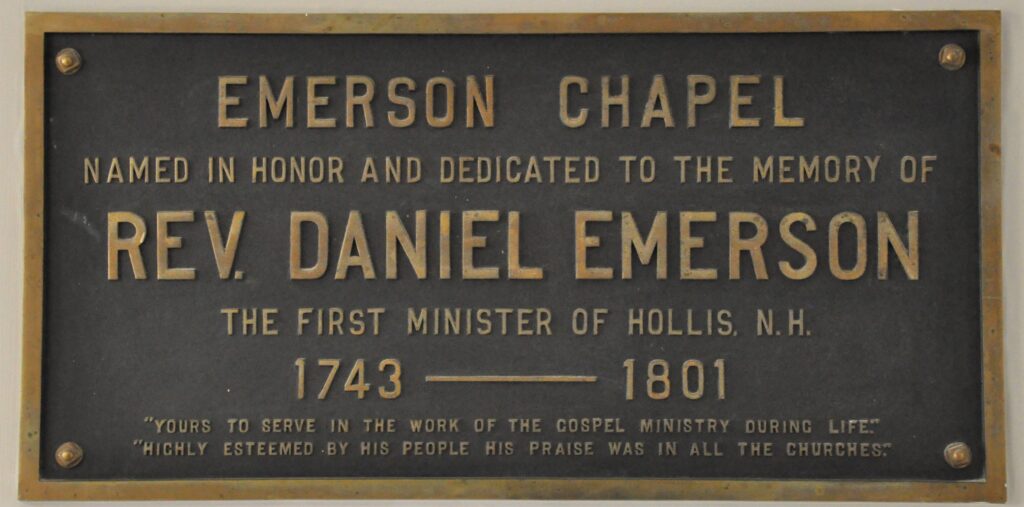By Cindy Ryherd
Reverend Daniel Emerson: Loving Husband and Father
This is the final part of a three-part series about Reverend Daniel Emerson, first pastor of what is now the Congregational Church of Hollis, U.C.C. (see April Chimes for Part I and May Chimes for Part II). Part I ended with Reverend Emerson being ordained in April 1743, building his home (Emerson House) on the 40 acres of land he was given as part of his contract (on the Hollis Town Common), and marrying the love of his life, Hannah Emerson. Part II covered Daniel Emerson’s professional, community, and patriotic contributions as pastor, teacher, soldier, public servant, and original “Friend(s) of the Library”, as well as his resting place and epitaph. Now we get to learn more about Daniel Emerson on a personal level, and particularly about his wife, Hannah, with whom he shared an unbounding love.
About Hannah
Daniel Emerson’s wife (and second cousin), Hannah Emerson Emerson was born December 3, 1722, in Malden, Massachusetts to her parents Reverend Joseph Emerson, Sr. and Mary Moody Emerson. Through Hannah’s younger brother, Reverend William Emerson, Sr., she is the great-aunt of Ralph Waldo Emerson. Like everyone of Colonial times, she was familiar with hardship and loss, even at a young age. At 1 ½ years old, she survived the burning down of the new family home in the middle of the night, and in 1734, she lost her newborn brother, Waldo. She was also afflicted with hearing loss early in life (more on that later). But in the years 1735 to 1739, things were looking up. Her father’s handsome, athletic, tall cousin Daniel, would sometimes walk over from Harvard in Cambridge for a visit. The “spark” that began then continued to smolder, eventually being fanned into a full-blown flame, culminating in their marriage on November 11, 1744, a year and a half after Reverend Emerson had been ordained as the first settled pastor for the small church of West Dunstable Parish (now the Congregational Church of Hollis).
Hannah would have taken the role and duties of minister’s wife with ease after her years of experience as a minister’s oldest daughter and having many other ministers in her extended family. Her brother, Reverend Joseph Emerson, Jr. came as the first minister to the new parish just south of Hollis called the West Precinct of Groton (which eventually became Pepperell), and in fact, her husband made the opening prayer at her brother’s ordination in 1747.
Exactly ten months after marrying Daniel on September 11, 1745, Hannah gave birth to their first of thirteen children, daughter Hannah. She spent the next 20 years having children every one to two years and at 43 years old, she gave birth to their last child, William Emerson, on December 11, 1765. Even by today’s standard, 43 years old would be considered high risk, and she would have had none of the conveniences of today’s modern medicine! Hannah and Daniel faced the death of one child at birth (Rebecca), three children before age ten (Mary, Ebenezer and William), and two more children pre-deceasing them as adult children (Joseph and Ralph). All but two of Hannah’s siblings would pre-decease her, losing her brothers Joseph and William in 1775 and 1776, respectively, as a result of illness incurred during their time in Revolutionary War camps. Losing Joseph, living in nearby Pepperell, was particularly hard on her.
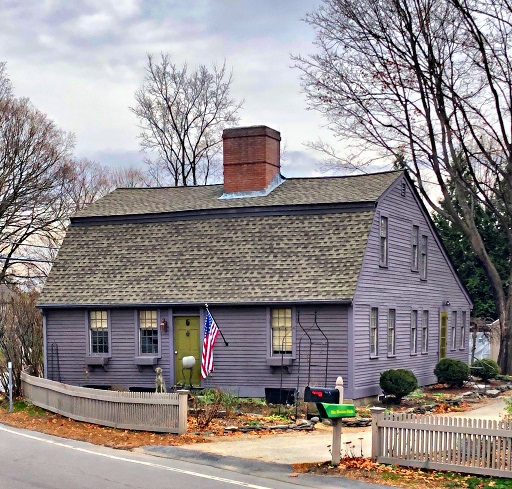
Her eldest son, Daniel Emerson, Jr. became a Deacon of the Hollis Congregational Church in 1775, married, and took residence a short distance away at 5 Broad Street (ca. 1764-68; another of Hollis’ oldest homes), giving Hannah and Daniel grandchildren within a few years of having their own youngest child. They watched four times as their eldest son, Daniel, Captain of Militia, went off to fight in the Revolutionary War, nearly every time one of his younger brothers coming with him (Peter, Ralph, and Samuel) as they became old enough to go (only 15 or 16 years old). Peter, toward the close of the war, having studied medicine, served as a surgeon. Most happily, all came safely back to her, however, she ended up losing Ralph in 1790 when, on the Hollis Common, Ralph was killed by the accidental discharge of a cannon during Militia practice, leaving a wife and two small daughters to mourn with Hannah.
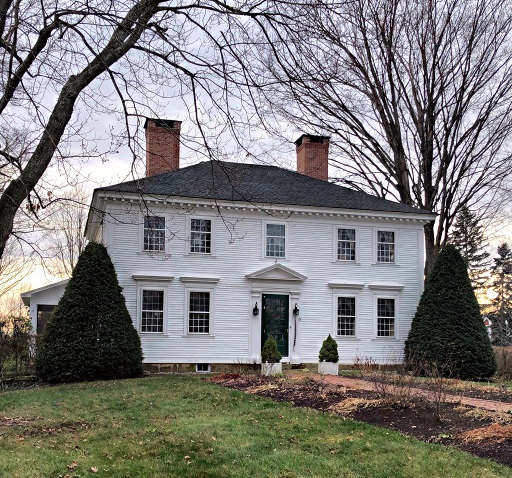
Reverend Daniel Emerson and Hannah had the pleasure of seeing their granddaughter, Ama Emerson Smith, daughter of their son Deacon Daniel, Jr., marry Reverend Eli Smith. Reverend Smith was Reverend Emerson’s successor as pastor of the Hollis Congregational Church. He and Ama lived in the stately, white Georgian house at 9 Monument Square, built for them in 1794-1797 on the Hollis Common, facing the church. Together they had six children. Reverend Eli Smith served as pastor of the Hollis Congregational Church for 38 years, from 1793 to 1831 (co-pastor with Reverend Daniel Emerson from 1793-1801).

As mentioned previously, early in Hannah’s life, she was afflicted with hearing loss. It is unknown exactly when, but at some point, she became so very deaf that the Hollis people bought, or had made for their beloved first lady of the church, a beautiful chair for the pulpit platform, where, with her long ear trumpet, she could sit near the speaker to hear better. The church also dedicated front-row benches near the pulpit for elderly congregants who were hearing impaired, being an early adopter of caring for those with disabilities. A grandson, who remembered her well, wrote that after she became unable to hear her husband, in their social prayers she was accustomed to take the lead. We may well believe that this was at the suggestion of the loving husband with his unbounded admiration.
The Love of Daniel and Hannah Emerson
In 1755 Daniel came to feel that it was his duty to leave his wife and children to serve as Chaplain with the Hollis company led by Captain Peter Powers at the Expedition to Crown Point (part of the French and Indian War expeditions), leaving July 8 of that year. At home with Hannah at that time were six young children, ages two months to nine years old. Certainly, having her brother Joseph in nearby Pepperell would have given her great comfort. It is during Daniel Emerson’s stay at Lake George, NY, that several love letters were written to one another, confirming a very deep, sincere, and abiding love for one another.
Addressing her husband as “Dear Sir”, on August 5 poor Hannah wrote how melancholy she found life living without him, especially on the Sabbath. Though only a month had passed since he left, and he had been home on leave a week, the time of his absence seems “long already” and she is anxious to know when to expect his return. Reaching him at Albany on August 20th, he treasured this short letter and kept it all his life. In letters back to her, he tells her, “It was like cold water to a thirsty soul” and he wrote in his journal that his wife’s letter refreshed his spirit. Calling Hannah “Dearest of Creatures” he “longs to see her above what tongue can express.” He writes “Pray my dear don’t call this flattery or think as you used to say, I could express myself better on this subject than on others, for if I had Solomon’s pen dipped in love, I could not write what my whole heart beats toward you.” “O, I fear that you possess too much of my affections, and if anything destroys me ‘twill be idolizing you, but I fear I shall offend your modesty, yet you must remember that a living spring will keep bubbling.” “Let us wait upon God for his presence with us in our absence and for leave to meet again in this world, but if otherwise may we meet together in Heaven.”
The “Dog Letter”
The most amazing story and letter from Reverend Daniel Emerson to his wife Hannah during his time at Crown Point in 1755, is the letter affectionately known as the “Dog Letter”. It is preserved between glass at the Hollis Historical Society and at only 6” x 7”, it is crowded by fine writing still legible despite being over 250 years old. You see, Reverend Emerson, in addition to his Bible, brought his favorite dog with him to Lake George. The trek is 120 miles as the crow flies but likely nearly 2x that distance as they traveled on horse and foot, taking weeks to arrive.
In this letter, dated September 19, 1755, Daniel Emerson outpoured his overwhelming love and devotion to Hannah. He then wrapped it well in oiled silk, sewed it in a buckskin packet, fastened it to his dog’s collar, and told the dog to “go home”. Weeks later, lean and limping, the faithful dog scratched at the door in Hollis. What a day of excitement it must have been for the children and Hannah as she untied the package from the dog’s neck, carefully unwrapped the contents of an unsigned letter from Lake George, and read:
“My dear wife. If you could by a window look into my heart, I believe you would find that you possessed as much of me as ever woman did of any man’s heart on Earth. I fear I spend too much time in thinking about you. My children are very dear to me you know & blest be God we have such pleasant ones, but you do out way them all. I hope God is & has been the health of your countenance & your God. I hope to see you dearest of mortal creatures before October is out if God will. I hope you & I shall be resigned to God’s will in our absence and be bettered fitted & prepared to live His promise together than ever we were. I wish I may be enabled to be as kind a husband as ever lived. I know you do deserve to be treated well, let my conduct be what it will – I can see many mistakes in my behavior. I wish I may but darst not promise to conduct better knowing I am nothing. My Dear I still thank you for your love, tenderness & truthfulness constantly exercised toward me ever since I knew you. I pray the God of our Fathers may bless you & our dear little ones. I hope you are all in health.” After providing some instructions, he continues “I wish all the Blessings of the mediatous purchase pray God to make up my absence to you in the more abundant effusions of his holy spirit on you & family. O my dear, like Apprentices Union by Fays tis long, long, long since saw you, I commend you to God who is able to keep you from falling & fill you with all good, but if you do wont to see me as I do you, I pity you from my heart. My love to you & children.”
See image of the actual letter at the bottom of this post.
Too bad this happened pre-Victorian time. I believe a letter such as this would put to good use a fainting chaise lounge common to that era! This letter could easily make any love-sick woman, especially one exhausted from single-parenting six young children, swoon!
Other than Daniel’s two absences because of military service during the French and Indian Wars (1755, and again in 1758), through all the trials and tribulations as well as events of great happiness, Hannah had her beloved husband, Daniel, by her side until he passed on September 30, 1801. Hannah would live another 10+ years, passing away at age 90 on February 28, 1812. She is buried with Daniel in the Hollis Church Cemetery, her epitaph reading:
Here are also deposited the remains of Hannah Emerson, wife of the above and Daughter of the Rev. Joseph Emerson, of Malden. She lived a pattern of filial obedience, respect, and affection; And an example of conjugal love and duty; a most tender, indulgent, and faithful Parent, the delight of her Friends and ornament of the Church; She lived the life of a true Disciple of Christ, In the constant exercise of active faith in His promises, and died in triumphant hope of everlasting life in those Regions where Charity never faileth, February 28, 1812, aged 90.
Despite this being a 3-part series that hopefully readers have found interesting and informative, there is so much more that could be written! Easily a book could be written about Reverend Daniel Emerson, his wife Hannah, their children, and their extended families (Hannah’s mother’s story is intriguing as well!) I encourage you to visit the Hollis Historical Society where they have the Emerson Genealogy book as well as History of the Town of Hollis (from its First Settlement to the Year 1879) by Samuel T. Worcester. These, along with church archives and Google, have been invaluable resources for my research.
I will be taking the summer months off but plan to resume writing “…And the Rest is History” articles in September 2021.
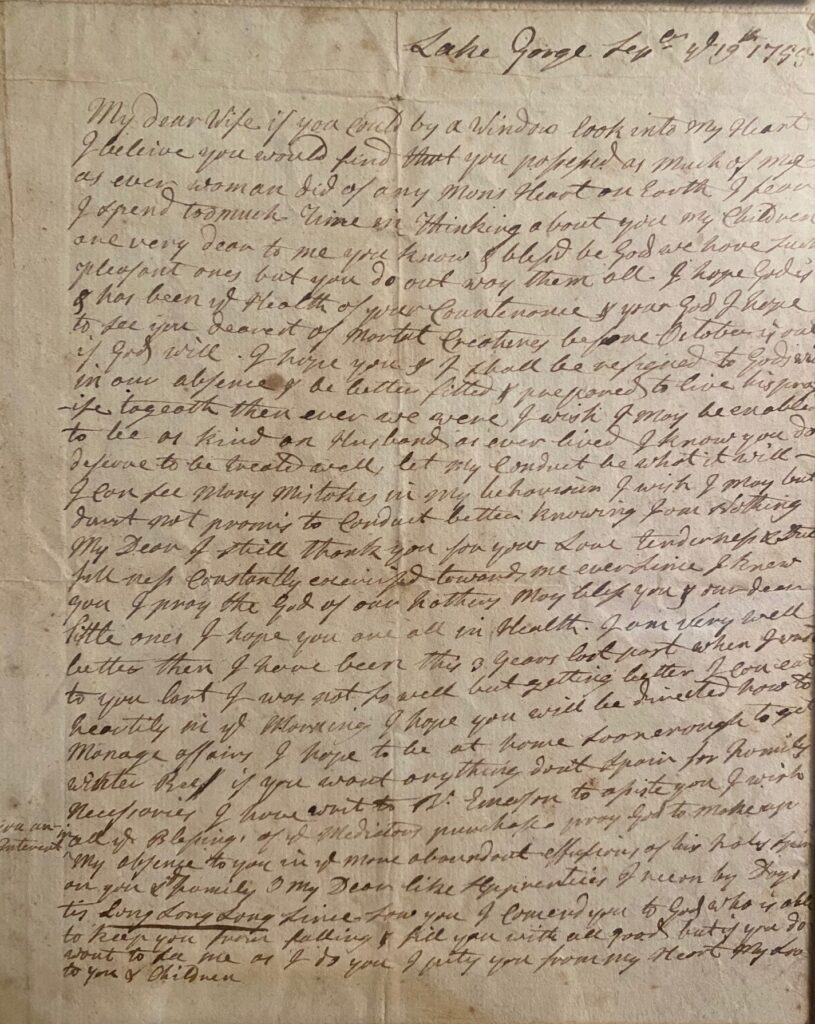
“A people without the knowledge of their past history, origin, and culture is like a tree without roots.” Marcus Garvey
